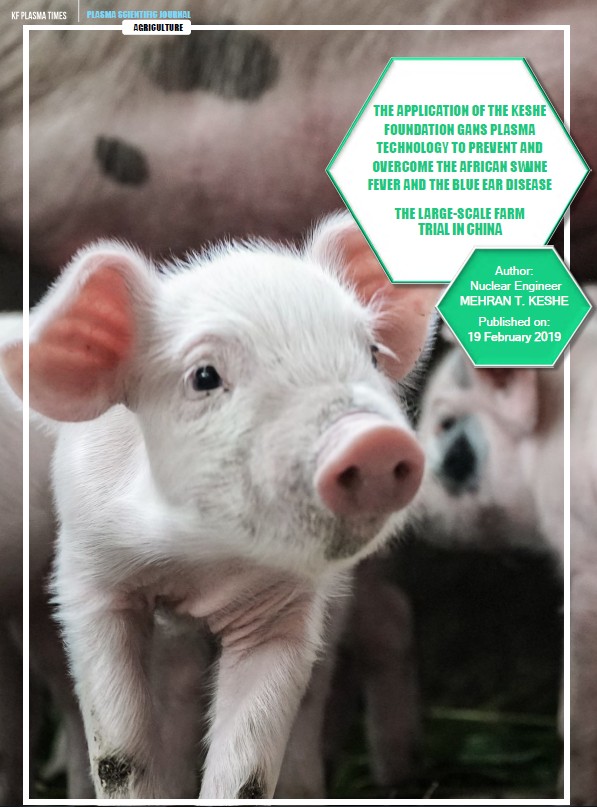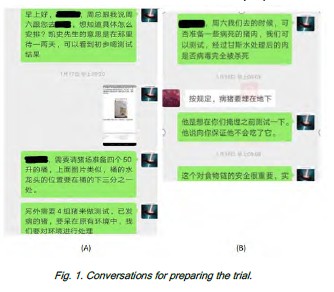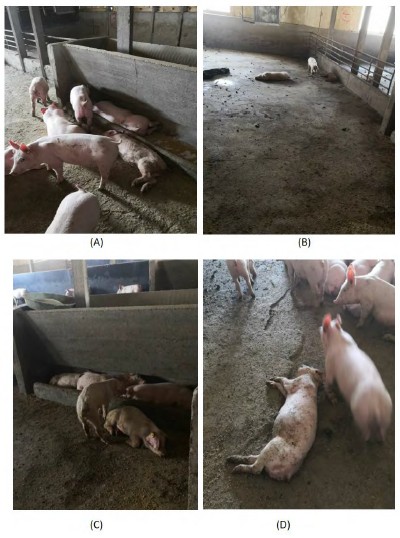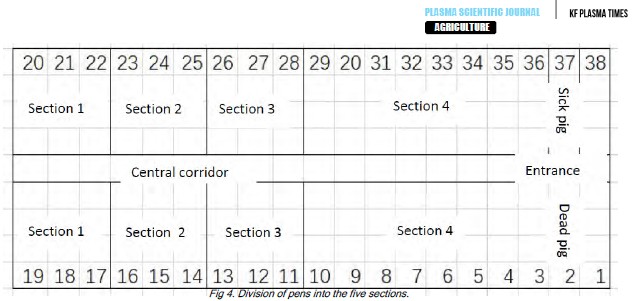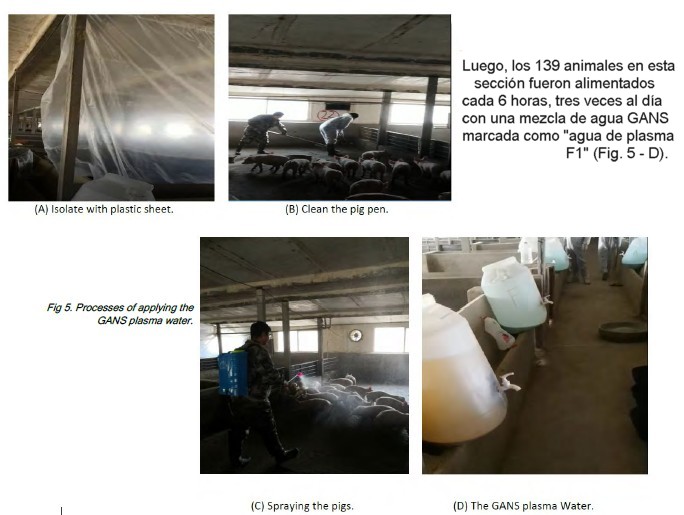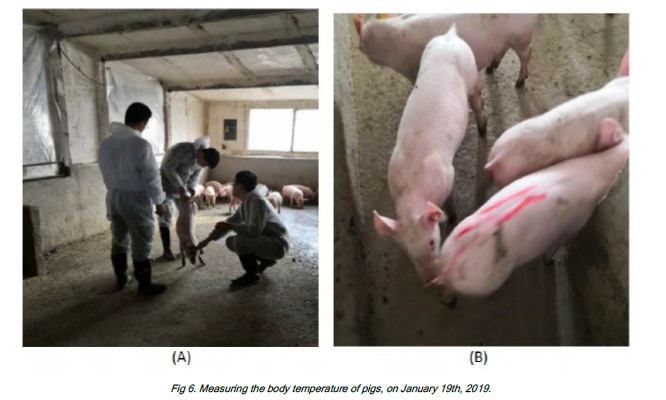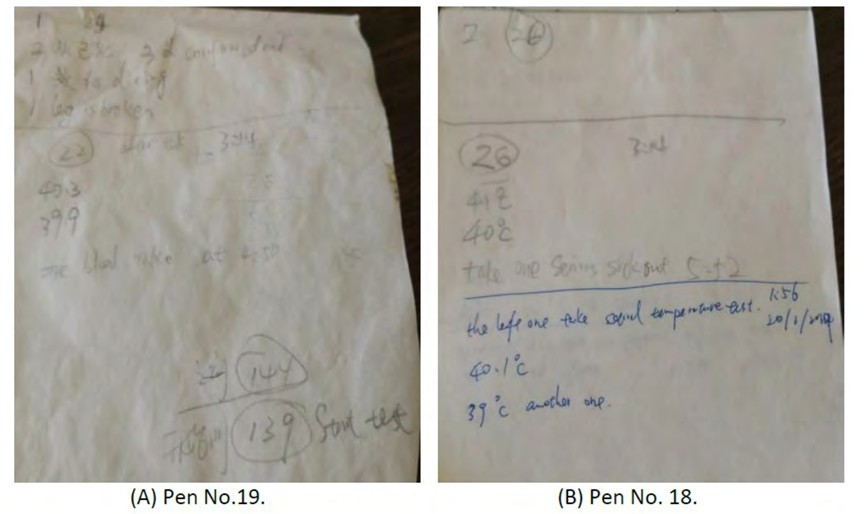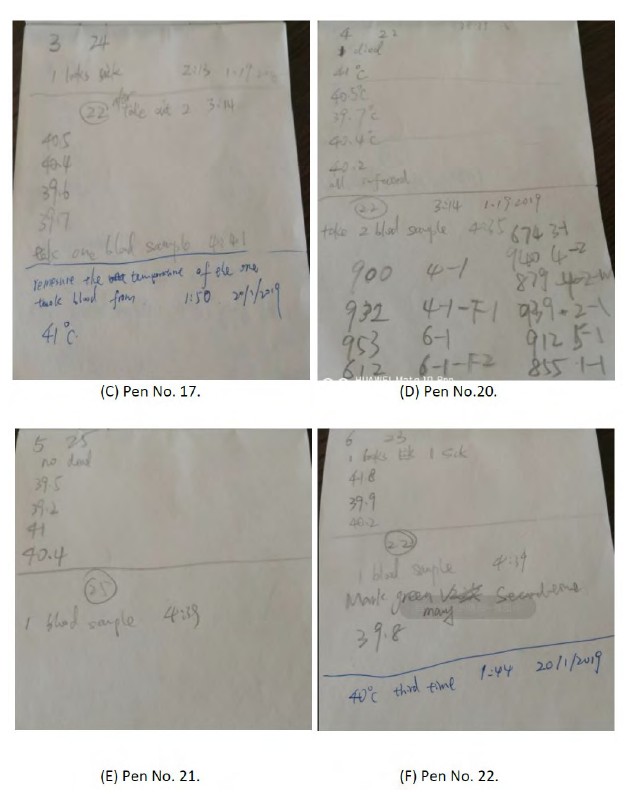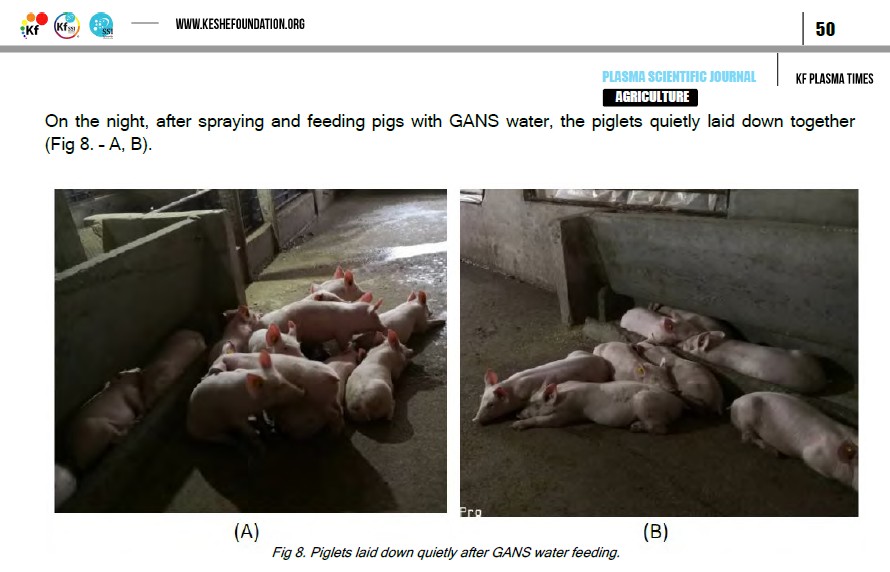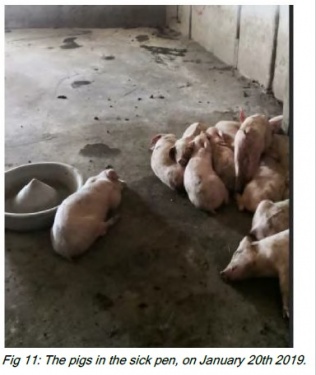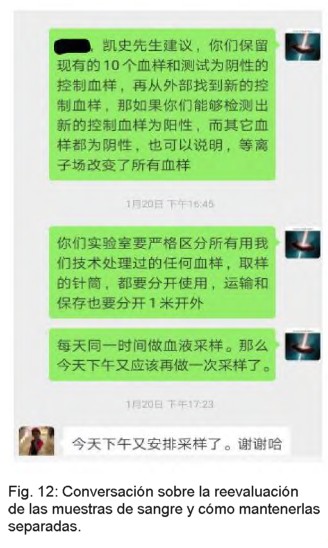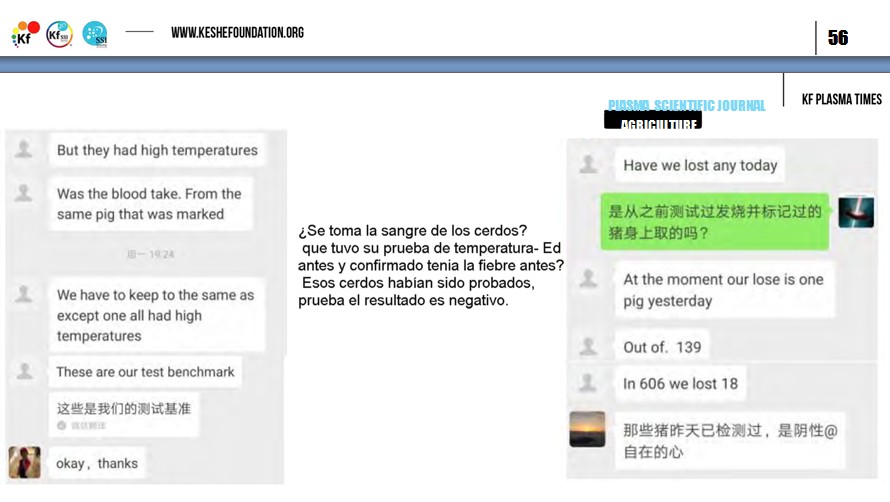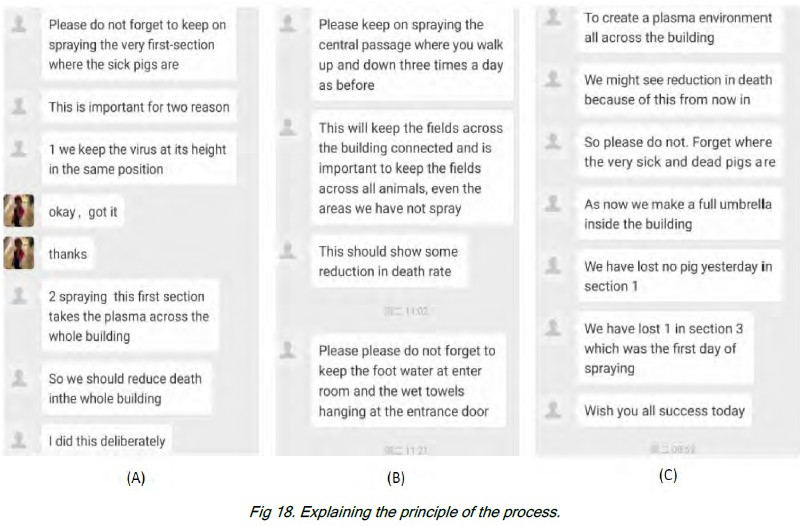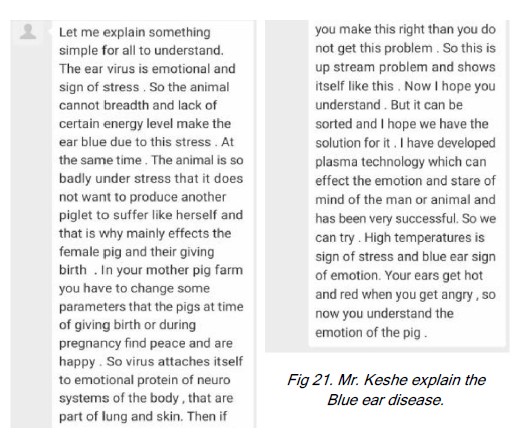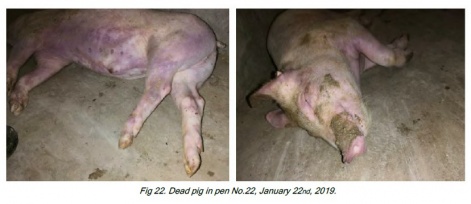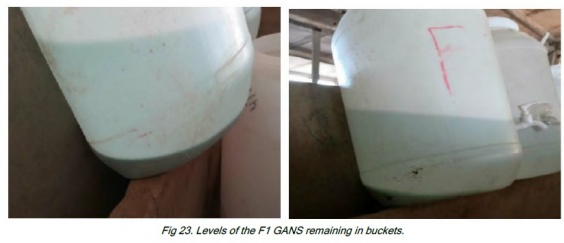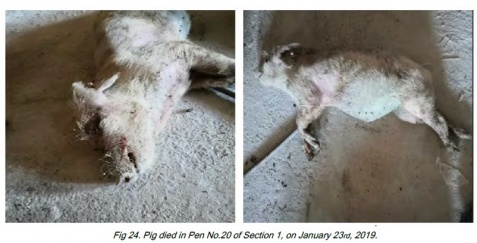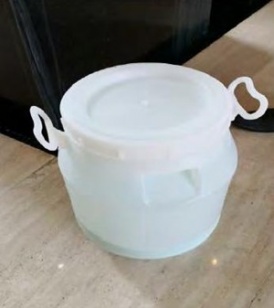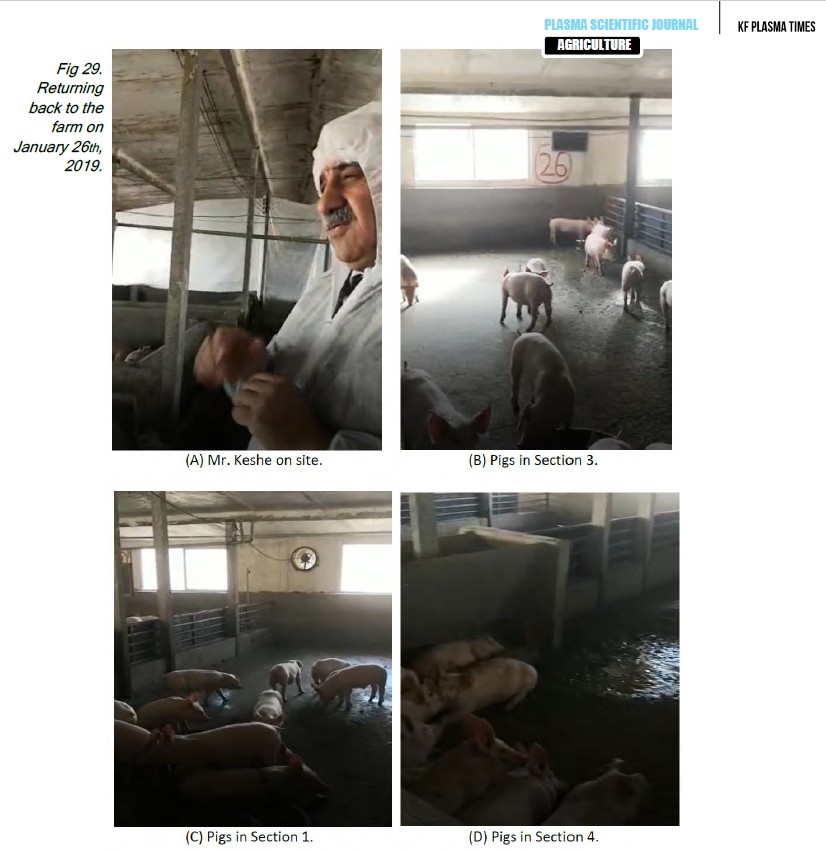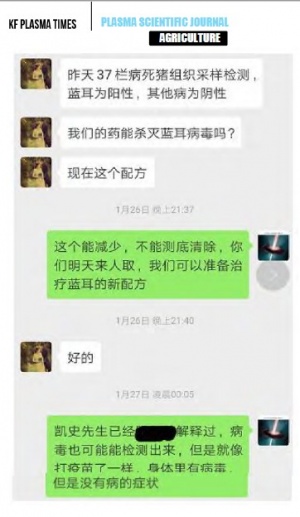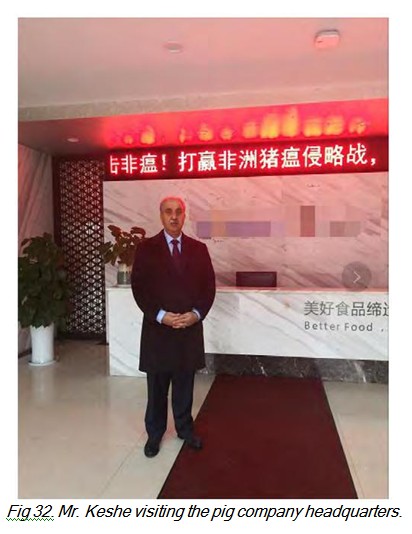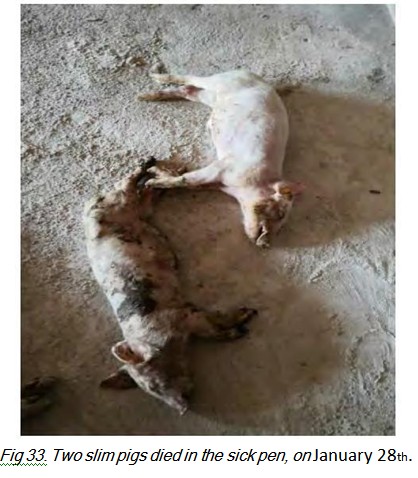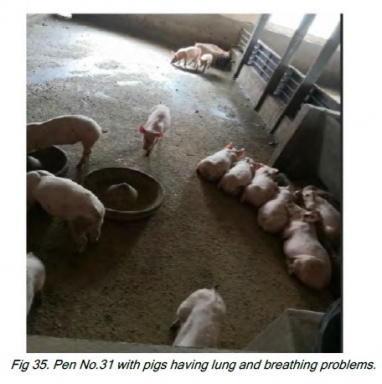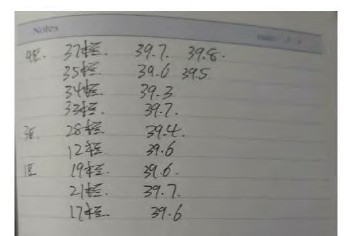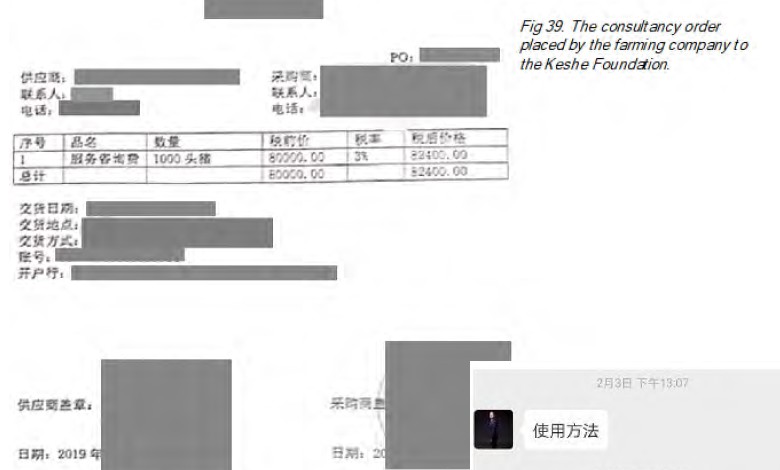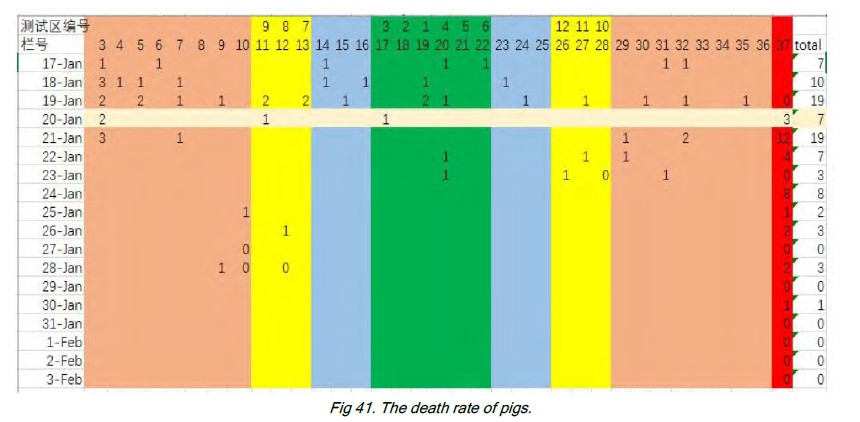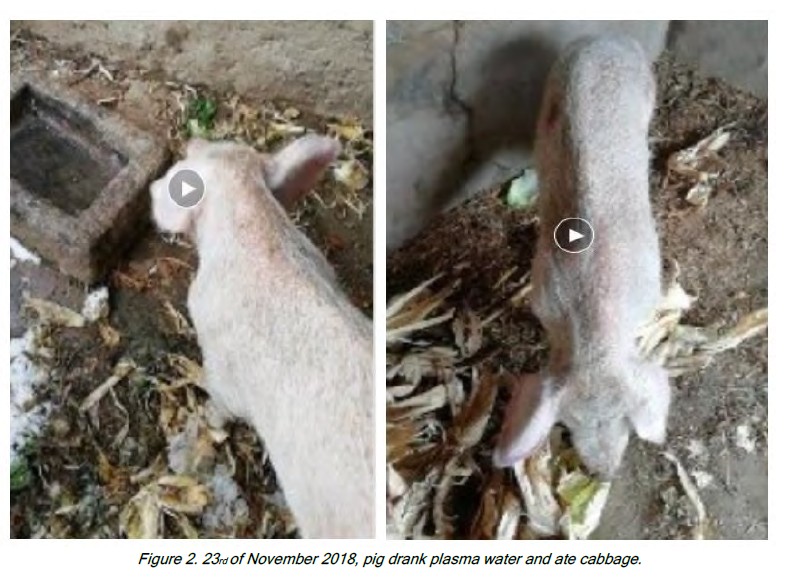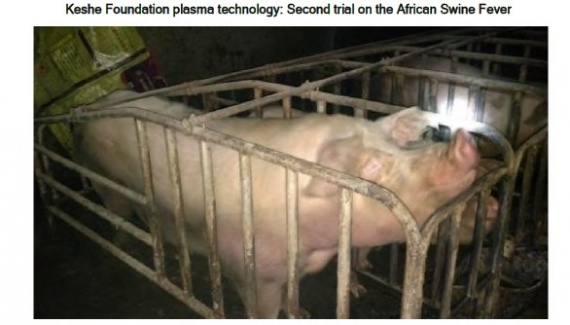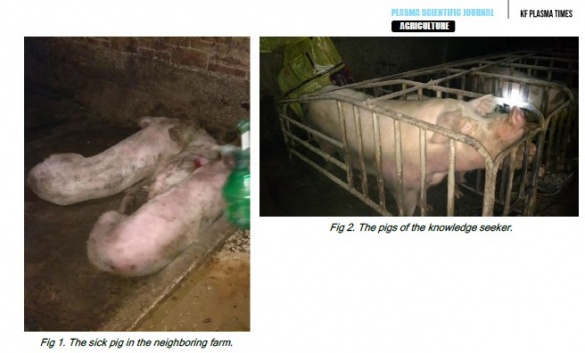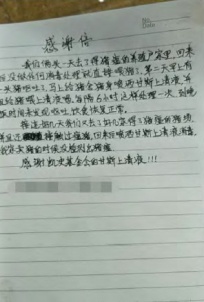La aplicación de la tecnología de plasma GANS de la Fundación Keshe para prevenir y superar la peste porcina africana y la enfermedad de la oreja azul en un ensayo agrícola a gran escala en China
This article is part of the KF Plasma Times April 2019
Sitio de prueba: granja de cerdos con un edificio que contiene 829 cerdos, de 50 días de edad, con un peso promedio de 25 kg. Prueba llevada a cabo por solicitud de los funcionarios del gobierno chino con la Fundación Keshe que proporciona la Material y agricultores aplicando la tecnología de plasma. Colaboración: científico de la Fundación Keshe, la gerencia de la granja, sus especialistas, trabajadores agrícolas. y el renombrado profesor chino que supervisa el proceso en la cría de animales vivos. La empresa porcina que posee y opera varias granjas con 2 millones de cerdos en China. Fecha de prueba: del 19 de enero de 2019 al 3 de febrero de 2019.
Sumario
- 1 Contenido
- 2 ANTECEDENTES DE LA PRUEBA
- 3 VIRUS
- 4 INTRODUCCIÓN M.T. K ESHE DE LA NUEVA CIENCIA Y TECNOLOGÍA POR EL CIENTÍFICO NUCLEAR
- 5 Proceso de juicio
- 6 COMMERCIALIZATION OF REVERSAL AND PREVENTION
- 7 OBSERVATIONS FROM THE TRIAL
- 8 CONCLUSIONS
- 9 A PPENDIX A
- 10 A PPENDIX B
Contenido
[[null show]]
ANTECEDENTES DE LA PRUEBA
El éxito de los dos primeros ensayos de tratamiento de la peste porcina africana por parte de la Fundación Keshe, ha atraído la atención del departamento pertinente en el sector de la cría de cerdos en China.
=== 1.1. PRIMERA PRUEBA === En la primera prueba llevada a cabo por la Fundación Keshe, la tecnología de plasma GANS se aplicó a un cerdo que durante 3 meses sufrió la PPA. En este caso, al agricultor se le suministró el agua de plasma GANS y se la aplicó de acuerdo con las instrucciones recibidas. Dentro de los 3 días, se observaron los primeros signos de recuperación y dentro de los 7 días, el cerdo no mostró ningún signo de fiebre y entró completamente recuperado (caso completo documentado en el Apéndice A).
=== 1.2 SEGUNDA PRUEBA === El segundo ensayo demostró la reversión y prevención exitosas en cerdos infectados por la PPA, tratados en los primeros dos días de la detección de la enfermedad. Cuando el agricultor descubrió por primera vez los síntomas del vómito y la falta de apetito en la granja de sus 30 cerdos, la tecnología de plasma GANS fue inmediatamente administrada por él. La granja estaba ubicada en el área altamente infectada de ASF y el agricultor es uno de los buscadores de conocimiento, después de la Fundación Keshe. Se puso en contacto con la Fundación y solicitó ayuda, por lo que los materiales de GANS se le entregaron de inmediato. La granja de cerdos y todos los cerdos fueron rociados y regados inmediatamente por el agricultor con el revolucionario agua de plasma GANS. El agricultor notó de inmediato el paro de la propagación del virus al resto de sus cerdos y, después de dos semanas de no observar ningún síntoma del virus, logró vender sus cerdos en el mercado (el caso completo está documentado en el Apéndice B).
=== 1.3 TERCERA PRUEBA === Tras el éxito del primer y segundo ensayo, la Fundación Keshe mantuvo a los funcionarios del gobierno chino informados y conscientes de sus logros y solicitó un ensayo de prueba más amplio, esta vez para ser observado y controlado por observadores y funcionarios independientes. A mediados de enero, la Fundación Keshe fue notificada por el profesor líder designado por el gobierno, para estar listo para una prueba de 80 cerdos. En respuesta, la Fundación preparó materiales listos para este caso de prueba.
El Departamento de Seguridad Nacional organizó una reunión con expertos de la industria. Luego de explicar en detalle, el principio de la tecnología de plasma para eliminar virus y el proceso de aplicación de la tecnología de plasma, el profesor organizó la visita de la Fundación Keshe a una granja, que pertenece a una gran empresa de cerdos en China, que fue infectada por el virus ASF. . El profesor y el director general de la compañía, por escrito, confirmaron a la Fundación Keshe que en una de sus granjas, varios cerdos dieron positivo para la PPA. El profesor y los funcionarios del gobierno solicitaron a la Fundación Keshe que emprendiera un ensayo de reunión más grande que el planeado originalmente, que involucró a 829 animales. El representante de la Fundación Keshe, junto con el citado profesor, el director general, el gerente general y el equipo de técnicos y agricultores, asistieron a la granja infectada el sábado 19 de enero de 2019. Esta empresa agrícola, en 2018, crió y vendió más de 2 millones de cerdos. El profesor informó a los funcionarios de la Fundación Keshe que la compañía perdió miles de cerdos en los últimos meses desde el brote del virus en China, lo que ha tenido un gran impacto en el negocio de la compañía.
Al asistir a la granja por parte de la Fundación Keshe y la administración de la empresa, se implementó de inmediato el proceso de reversión y prevención. Luego se dejó a la gerencia, los trabajadores y los técnicos de la empresa observar y documentar los resultados del proceso iniciado. La Fundación Keshe visitó la granja el sábado siguiente y la empresa se mostró satisfecha con los resultados.
Después de 14 días del inicio del ensayo, la Fundación Keshe y la gerencia de la compañía se reunieron el 28 de enero, en presencia del Presidente, en la sede de la compañía. Sobre la base del éxito de las pruebas iniciales, la compañía solicitó a la Fundación Keshe que proporcionara materiales para la prevención del ASFV y el virus del oído azul, para una de sus granjas de cerdos madre, donde habían identificado positivamente el virus ASF. El material de agua GANS para este fin se entregó a la empresa el 3 de febrero y se aplicó en la cohorte de 1000 cerdas preñadas. En el momento de compilar este informe (13 de febrero), la Fundación Keshe no ha recibido ningún informe de la compañía sobre pérdidas o casos de infección en la granja.
VIRUS
=== 2.1 VINO AFRICANO PARA TODOS LOS VIRUS === El virus de la peste porcina africana es un virus de ADN bicatenario de gran tamaño que es el único miembro del género Asfivirus dentro de la familia Asfarviridae (Asfar = peste porcina africana y virus relacionados). El virus de la peste porcina africana es el único arbovirus de ADN conocido y se transmite por garrapatas del género Ornithodoros. Las cepas de virus se distinguen por su virulencia a los cerdos, que va desde una infección altamente letal hasta una infección subclínica. Las cepas de virus también pueden diferenciarse por sus secuencias genéticas, y varios genes codificados por virus, incluido P72 (también conocido como P73) que pueden usarse para genotipar el virus; sin embargo, la diversidad genómica del virus en la naturaleza, queda por caracterizar a fondo. El genoma del virus de la peste porcina africana contiene un complemento único de familias multigénicas.
=== 2.2 VIRUS DE SÍNDROME RESPIRATORIO Y REPRODUCTIVO PORCINO === El síndrome respiratorio y reproductivo porcino (PRRS, por sus siglas en inglés), también llamado enfermedad de la oreja azul porcina, es una enfermedad altamente contagiosa causada por el virus del síndrome reproductivo y respiratorio porcino (PRRS). Concomitante como reproductivo inferior, dificultad para respirar y oreja azul o púrpura, y que causa otras enfermedades infecciosas, son sus características principales. El virus de la enfermedad de la oreja azul de porcino es un virus de ARN de cadena simple, que carece de un mecanismo correctivo en el proceso de infección y replicación viral y produce una alta tasa de mutación del virus de la descendencia. La tasa de mutación del PRRS es 1.000 veces mayor que la de otros virus de ADN, 1 millón de veces más rápido que el genoma de los mamíferos.
INTRODUCCIÓN M.T. K ESHE DE LA NUEVA CIENCIA Y TECNOLOGÍA POR EL CIENTÍFICO NUCLEAR
=== Un nuevo descubrimiento y comprensión === La nueva tecnología de plasma GANS de la Fundación Keshe fue desarrollada para aplicaciones de virus en el espacio profundo y, como se informa en este documento, resuelve con éxito los casos de virus AFS y PRRS. En colaboración entre los científicos de la Fundación Keshe y la Universidad South Sierra Leone, a través de las pruebas y la confirmación de la efectividad de la tecnología de plasma en los ensayos de virus de Ébola en África, se ha puesto de manifiesto que la nueva tecnología de plasma espacial es muy efectiva cuando se trata de virus. Hasta ahora, el mundo de la ciencia tenía problemas para comprender la operación, el funcionamiento y los efectos de los virus en las células humanas y animales. La medicina moderna desarrolló antibióticos para tratar las células infectadas, pero nunca comprendimos completamente el funcionamiento de las células que están infectadas por un virus. La ciencia del plasma nos enseña que debemos considerar los virus como paquetes de energía que se unen y se unen a las células orgánicas y hasta que se use toda la energía de este paquete de energía, los signos del virus estarán presentes en esa célula en el ser humano o animal. cuerpo.
La nueva tecnología espacial de la Fundación Keshe, mediante la aplicación de paquetes de energía de plasma producidos por el material GANS, tiene la capacidad de agotar la energía del virus que se adhiere al aminoácido o a la célula, creando una condición que causa El virus desaparecerá inmediatamente de la célula afectada. Donde, la energía del virus ahora tiene una fuerza mucho más débil es la entrega al plasma GANS que no tiene ninguna fuerza del virus original. Donde la energía del virus se divide en un campo más débil en el plasma GANS. Con este agotamiento de la energía del virus, el virus vive detrás de las células dañadas que pueden provocar infecciones secundarias y, al mismo tiempo, debido al agotamiento de la cadena más fuerte del virus, la energía que permanece en algunas células, se comporta y se convierte en el segundo virus más débil en la fuerza del campo magnético de energía, que afecta al ARN de los animales. La cadena débil de ARN, ahora se manifiesta en algunas de las células débiles o nuevas células como un virus de ARN, conocido como el oído azul. La nueva hebra de ARN del virus ahora crea un virus secundario conocido como virus del oído azul. Luego, la nueva cadena de virus, se adhiere a nuevas células y conduce a la creación y observación de altas temperaturas y fiebre, después de la primera temperatura causada por el virus de la peste porcina africana. Aplicación continua de una nueva tecnología de plasma GANS con el agua de GANS de fuerza más débil para igualar la fuerza de la fiebre del oído azul para alimentar por segunda vez a los animales para agotar la energía del nuevo virus que involucra al nuevo virus del oído azul y erradicar por completo El nuevo virus. Como en el caso de la peste porcina africana, este nuevo virus secundario erradicado deja algunas células dañadas en el cuerpo del animal, que estas células dañadas conducen a la manifestación de una infección secundaria, como en el caso de la peste porcina africana, que Las nuevas células dañadas conducen a la manifestación de un segundo ciclo de alta temperatura en el cuerpo del animal. Por lo tanto, M.T. Keshe usa un tercer material nuevo de fuerza de plasma GANS en la fuerza del antibiótico. Este tercer GANS por prueba en laboratorios en Europa respalda que este GANS es muchas veces más potente que cualquier antibiótico, dado a los animales durante el período de dos infecciones de la peste porcina africana y la fiebre del oído azul en el cuerpo de los animales se reducirá y reducirá. eliminar la fiebre. MONTE. Keshe sugirió y mostró en el ensayo de 829 cerdos que la introducción del agua de plasma GANS al medio ambiente de toda la granja de cerdos, convierte de inmediato la peste porcina africana y, en consecuencia, la manifestación del virus del oído azul. El uso del agua plasmática para el control de la infección en uno de los grupos de prueba, superó al virus y su infección. Se recomendó a la compañía que proporcionara amoxicilina en la sección tres y cuatro y que en 7 días salvó la vida de todos los animales infectados en los grupos de control en el edificio. Dentro de los 14 días de la aplicación, no hay signos del virus ni de la fiebre en ninguno de los animales infectados en la granja. Antes de la aplicación de la tecnología de plasma, todos los animales mostraban los síntomas de fiebre alta. Este es un gran avance en el mundo de la ciencia y desde este punto en adelante es posible manejar y superar cualquier virus que infecte a animales o humanos. La solución es encontrar la fuerza del virus y simplemente desarrollar una hebra más débil de la misma fuerza. De modo que, a medida que el virus entrega su energía al nuevo agua de plasma GANS, pierde su fuerza / energía y no deja signos del virus. Este es un gran avance en el mundo de la ciencia y una nueva comprensión del trabajo de los virus en el espacio que ahora es descifrado por la física nuclear iraní, experta en la tecnología de plasma espacial. El desarrollo y la aplicación del nuevo material de plasma conocido como Gas en sólido nanoestado (GANS) se probaron con éxito en varios ensayos en China en las áreas de la agricultura, lo que aumentó la cosecha y en aplicaciones médicas de la tecnología a través de Europa. Sistemas de salud certificados.
'Notas:' Debe entenderse que, en la tecnología de plasma GANS, los campos gravitacionales magnéticos de energía de alta resistencia siempre alimentan los campos magnéticos de menor fuerza del mismo, para equilibrar la interacción de los dos. Por lo tanto, una gran cantidad de la misma fuerza siempre alimenta su energía a la cantidad más baja de la misma fuerza. Por lo tanto, en los virus, el paquete de energía del virus tiene que encontrar un campo coincidente en la intensidad del espectro de aminoácidos para poder interactuar y bloquear uno de los elementos del aminoácido. (O o H, N y C). Entender que todos los elementos del aminoácido de cada célula no tienen la misma fuerza explica por qué los virus pueden unirse a diferentes animales o humanos y solo afectan a ciertos animales o especies y no pueden cruzar a otros animales. El segundo aspecto que ahora se puede responder es que ahora que se consume la mayor fuerza de la hebra del virus, la hebra más débil se adhiere a través de la fuerza del ARN al elemento más fuerte del aminoácido de la proteína. En ese proceso, ya que está más cerca del elemento más fuerte de la proteína, el intercambio de la energía del virus a la proteína es menor y, por lo tanto, esto provoca un daño más débil y menor a las células del cuerpo del animal. Por lo tanto, el animal puede vivir una vida más larga, pero aún muestra el efecto del mismo virus o la mutación del mismo, si la fuerza de la cadena más débil del virus tiene la misma fuerza del ARN que la fuerza del ADN más débil. Por lo tanto, la fuerza de energía del ARN de la cadena más débil al tener la fuerza correspondiente al elemento más pesado de la proteína, ahora se enlaza a la célula animal como una cadena más débil del mismo virus, o similar a otra fuerza de la cadena del virus puede manifestarse y una forma totalmente nueva. Se puede observar virus. Debe entenderse que en la tecnología de plasma, cuando utilizamos el término "agua de plasma GANS", esta agua no es agua pura, sino que conlleva un potencial de campos magnéticos plasmáticos. Esto significa que cuando utilizamos agua de plasma GANS como agua de alimentación o pulverización, afecta a todo el entorno, incluso a varios metros alrededor del área de aplicación, cubriéndolo con los campos magnéticos del plasma, y no solo el área que está en contacto directo con él. . El agua de plasma de GANS establece una conexión de campo magnético y energético con el entorno y puede cubrir toda el área y no solo el área que se riega con ella. Por lo tanto, cuando rociamos o alimentamos a los animales, el campo del agua de plasma GANS se extiende por todo el cuerpo del animal, sin pasar por la sangre o la circulación de la linfa. Por lo tanto, la interacción en el cuerpo del animal o en el ambiente tratado con el agua de plasma GANS es instantánea. Como resultado, el efecto del agua de plasma en el entorno dado, puede durar semanas y meses.
Proceso de juicio
COMUNICACIÓN CON LA GRANJA PARA PREPARAR EL PROCESO
Fig. 1. Conversaciones para preparar el juicio. El 17 de enero de 2019, la Fundación Keshe recibió la confirmación de que se encontró una granja de cerdos infectada con el ASFV para realizar pruebas. La comunicación inicial con la Fundación Keshe fue preparar la granja para recibir y aplicar el nuevo material. Se dio instrucciones a la granja para que preparara un número de cubos de plástico de 50 litros, cada uno con un grifo colocado a un tercio de altura desde el fondo del cubo (Fig. 1 - A).
==== Traducción de la conversación (Fig 1. - A): A: ==== Buenos días, el director Zhou me dijo que el sábado iremos con usted a la granja. ¿Puedo saber los detalles del acuerdo? El Sr. Keshe quiere quedarse allí por un par de días para ver los resultados preliminares de la prueba. R: Necesitamos que la granja prepare cuatro cubos de 50 litros como se muestra en la imagen de arriba, el grifo debe colocarse a un tercio del fondo del cubo. R: Necesitamos cuatro grupos de cerdos para realizar la prueba, mantener a los enfermos en el entorno antiguo, debemos tratar con el medio ambiente. ==== Información adicional ==== Además del proceso y el tratamiento de los cerdos infectados, sugerimos que la granja puede esterilizar la carne de cerdos enfermos y muertos con el agua GANS para probar si elimina el virus de la carne del animal, lo que puede prevenir la infección. La carne ingresa a la cadena alimenticia (Fig. 1 - B). ==== Traducción de la conversación (Fig 1. - B): ==== R: ¿Es posible preparar algo de carne de los cerdos muertos cuando lleguemos allí el sábado? Queremos probar si el virus en la carne se puede matar con solo tratarla con agua GANS. B: Los cerdos enfermos deben ser enterrados para seguir el reglamento. A: Solo quiere probar antes de que los entierres. Él promete que no lo va a comer. R: Esto es importante para la seguridad de la cadena alimentaria. === ENTENDIENDO LA SITUACIÓN EL VIRUS DE GRANJAS PORCINAS FRICANAS DE CERDOS Y CONFIRMANDO LA PRESENCIA DE === Fig. 2. Confirmación de que se detectó el ASFV en la granja de destino El 18 de enero de 2019, la información básica sobre la granja de cerdos se proporcionó a la Fundación Keshe y el profesor designado por el gobierno y el Gerente General de la compañía confirmaron que el análisis de sangre del laboratorio ASFV fue positivo.
Antes de la aparición del virus, se confirmó que había 829 lechones en el edificio de la granja. Estos cerdos tenían alrededor de 50 días y pesaban, en promedio, alrededor de 25 kg. Para el 18 de enero, quedaban aproximadamente 810 lechones, ya que 19 cerdos ya habían muerto en las primeras 24 horas.
Los síntomas clínicos comenzaron a aparecer en el edificio de la granja el 16 de enero, y las muestras de sangre de 10 cerdos se analizaron en el laboratorio el 17 de enero. Los resultados confirmaron la presencia del virus de la peste porcina africana.
Desde el 17 de enero, los cerdos en la granja comenzaron a morir: 7 cerdos murieron el 17 de enero, 10 murieron el 18 de enero y 19 el 19 de enero, antes de que el equipo de la Fundación Keshe llegara a la casa de los cerdos, a las 2 p.m.
Traducción de la conversación (fig. 2):
R: ¿Se verificaron los virus en busca de virus antes de nuestro ensayo?
B: Déjame comprobar. B: Ya confirmado por medios de laboratorio. A: ¿Puedo preguntar cuántos cerdos había para probar? C: Total de 810, prueba muestreada, por lo que no es exactamente seguro qué cerdo estaba enfermo. C: Son lechones, de unos 50 días de edad, que pesan alrededor de 25 kg. C: Hay un edificio cercano, que también tiene más de 800 cerdos, alrededor de 130 días de edad, que aún no muestran enfermedad. Este edificio necesita prevención, muy cerca, a tan solo 8 metros. C: No, mostraron síntomas clínicos el día anterior a ayer y, por lo tanto, enviaron las muestras al laboratorio para su análisis, el resultado muestra ASFV positivo. B: ¿Debemos centrarnos en la prevención mañana? C: El proceso es el aislamiento humano, el aislamiento de corrales y la desinfección del medio ambiente. Creo que estos 800 cerdos para hacer el proceso, y los otros 800 es hacer la prevención.I MPLEMENTATION PROCESS AND TRACKING FEEDBACK
DIA 1
En sitio
Los funcionarios de la Fundación Keshe fueron recogidos por el profesor y conducidos tres horas hacia la ciudad cercana a la granja. A la llegada, presentamos al CEO y al gerente general y al personal local de la empresa. El Sr. Keshe, el fundador de la Fundación Keshe, llegó al hotel a las 10:30 el 19 de enero, donde se reunió con los gerentes y el personal de la compañía de granjas porcinas para comprender su situación y explicó el esquema de aplicación y los principios de La nueva tecnología de plasma GANS. Al llegar a la granja de cerdos alrededor de la 1 p.m., observamos que uno o dos cerdos estaban muertos en cada corral debido al virus y que algunos de ellos no se habían sacado de la jaula (como se puede ver en algunas de las imágenes a continuación). El equipo de la Fundación Keshe tomó inmediatamente videos y notas de los cerdos enfermos. La mayoría de los cerdos estaban inactivos, pudimos observar la alta temperatura del color de la piel (color rojo brillante como lo señaló el personal de la empresa debido a la fiebre). La mayoría de los cerdos estaban amontonados, algunos corrales tenían trazas de vómito en el suelo y el excremento de los cerdos estaba dentro de los corrales. El olor del lugar era tan malo que después de un rato nos sentimos incómodos en la garganta y los pulmones, uno podía oler la muerte en la granja. Algunos cerdos estaban muy delgados y enfermos. En la última imagen (Fig. 3 - J) a la derecha, se puede ver que los animales muertos fueron colocados en bolsas para su eliminación. ===== Inicio del proceso en el sitio para revertir el virus ===== Debido a las limitadas materias primas que trajo la Fundación Keshe, ya que el plan original del profesor era procesar 80 cerdos en un sitio diferente, tuvimos que improvisar para cubrir tantos cerdos como pudimos y al mismo tiempo crear Aplicación y control separados para la máxima cobertura de toda la caseta de cerdos de 810 cerdos. Por lo tanto, el Sr. Keshe decide dividir toda la pocilga en cinco secciones y aplicar un proceso diferente a cada sección. Al igual que en la Fig. 4, desde la entrada, las 6 plumas más alejadas que incluyen tanto el lado izquierdo como el derecho, es decir, las plumas No. 17 a No.22, se etiquetaron como la Sección 1. Las siguientes 6 plumas, es decir No.14, No.15, No.16, No.23, No.24 y No.25 fueron asignados a la Sección 2. Los siguientes 6 bolígrafos, incluyendo No.11, No.12, No.13, No.26, No.27 y los bolígrafos No.28, fueron marcados como Sección 3. Los bolígrafos No.3 a No.10 y No.29 a No.36 constituyeron la Sección 4. El primer bolígrafo en el lado derecho de la entrada - bolígrafo No.37 - fue designado como la enfermería, donde todos los animales enfermos de todos los corrales fueron aislados antes de morir. La pluma número 2 fue designada como el almacenamiento de los animales muertos, con los animales empacados temporalmente en bolsas de plástico.Fig 4. División de bolígrafos en las cinco secciones. Las secciones 1 a la sección 4 se aislaron una de la otra colocando una gran lámina de plástico a través del edificio (como se muestra en la Fig. 5 - A). Fig 5 - A + B Fig 5 - C + D La Sección 1 se limpió luego de cualquier desperdicio animal (Fig. 5 - B) y luego se roció con la mezcla de agua GANS específica, etiquetada como W (recogida de la parte superior del recipiente de plástico) con los animales adentro. La superficie completa de los cuerpos de los animales ubicados en esta sección se roció con el "agua de plasma W" (Fig. 5 - C).
Al mismo tiempo, los cerdos muertos y aquellos con síntomas severos fueron removidos. Se midió la temperatura corporal de los cerdos al azar (Fig. 6 - A) y se marcaron los cerdos cuya temperatura corporal se probó (Fig. 5 - B).
Fig 6. Medición de la temperatura corporal de los cerdos, el 19 de enero de 2019.
Había 24 cerdos en el corral No.17, 2 cerdos estaban gravemente enfermos y, por lo tanto, fueron retirados, quedando 22 cerdos. La temperatura corporal de los cuatro cerdos elegidos fue de 40.5, 40.4, 39.6 y 39.7 grados Celsius, respectivamente (Fig. 7 - C). La pluma número 18, originalmente tenía 26 cerdos, con uno retirado debido a una enfermedad, dejándolo con 25 cerdos. La temperatura corporal de los dos cerdos seleccionados al azar fue de 41 y 40 grados centígrados, respectivamente (Fig. 7 - B). La pluma Nº 19, tenía 3 cerdos muertos y uno con una pierna fracturada, por lo que quedaron 22 cerdos en total en esta sección. La temperatura corporal de los dos cerdos seleccionados fue de 40.3 y 39.9 grados centígrados, respectivamente (Fig 7. - A). La pluma No.20, originalmente tenía 23 cerdos, se retiró un animal muerto y quedaron 22. La temperatura corporal de los cinco cerdos seleccionados al azar fue de 41, 40.5, 40.4, 40.2 y 39.7 grados centígrados, respectivamente (Fig. 7. - D). La pluma No. 21, originalmente tenía 25 cerdos, no se eliminaron los cerdos. La temperatura corporal de los cuatro cerdos seleccionados fue de 41, 40.4, 39.5 y 39.2 grados Celsius respectivamente (Fig 7. - E). La pluma Nº 22, originalmente tenía 23 cerdos, quedaban 22 después de la remoción de un cerdo gravemente enfermo. La temperatura corporal de los tres cerdos elegidos fue de 41.8, 40.2 y 39.9 grados Celsius, respectivamente (Fig. 7 - F). El número de cerdos en estos 6 corrales totalizó 145 antes de la remoción de cerdos enfermos y muertos, lo que dejó 139 cerdos al inicio del ensayo en esta sección (Fig. 7. - A). La temperatura corporal normal de un cerdo sano es inferior a 39,5 y, por lo tanto, la mayoría de los cerdos medidos mostraron los primeros signos de fiebre. Después de tomar medidas de la temperatura corporal, se pulverizaron tanto la pocilga como el cerdo, y se alimentó a los cerdos con agua GANS. Las muestras de sangre se recogieron después de una hora desde la primera alimentación de cerdos con agua GANS. De la pluma No.17, se recogió una muestra de sangre de uno de los cerdos y el número del tubo de ensayo es 674-1-1. Lo mismo se hizo para la pluma número 18 y el número de tubo de ensayo es 939-2-1. La muestra de un cerdo en la pluma No.19 tiene el tubo de ensayo número 855-1-1. De la pluma No.20, se tomaron muestras de sangre de dos cerdos, y cada muestra se dividió en dos partes. Para el cerdo No. 1, una muestra de sangre se marcó como 900-4-1, a la otra se le agregó agua 'F1 GANS' para probar el efecto del agua GANS en la sangre (muestra etiquetada como 932-4-1- F1). Para el cerdo Nº 2, una muestra de sangre se marcó como 940-4-2, a la otra se añadió agua WANS para probar el efecto del agua plasmática GANS en la sangre. El segundo número de tubos de ensayo se marcó como 879-4-2-W. En el bolígrafo No.20, se recogió una de las muestras de sangre del cerdo, el número del tubo de ensayo es 912-5-1. De la pluma No. 22, se tomó una muestra de sangre de un cerdo y se dividió en dos partes. Una muestra tenía la etiqueta 953-6-1, la otra tenía agua 'F2 GANS' agregada para probar el efecto del agua GANS en la sangre. El segundo tubo de ensayo fue etiquetado como 612-6-1-F2. Las muestras de sangre del grupo de control se agruparon, y la misma noche, se colocaron 10 muestras de sangre en una caja de papel y se enviaron al laboratorio para su análisis. Como se explicó en la introducción a la tecnología de plasma GANS, ahora debe entenderse que las aguas GANS se agregan a una serie de muestras de sangre enviadas al laboratorio para detectar la presencia del virus; los campos plasmáticos en estos tubos de ensayo afectan a todas las muestras de sangre y se esperaban resultados negativos por la presencia de virus ASF y PRRS.
Fig 7. Registro original de números de cerdos, medición de temperatura y muestras de sangre de los seis corrales de la sección uno.
En la noche, después de rociar y alimentar a los cerdos con agua GANS, los lechones se acostaron juntos en silencio (Fig. 8 - A, B).
Fig 8. Lechones depositados en silencio después de la alimentación con agua GANS. Todos los cerdos enfermos de las otras áreas no tratadas fueron trasladados a la pluma No. 37 por la entrada y se rociaron y alimentaron solo con agua "W GANS". En este punto, la longitud total del corredor central se roció con el "agua W GANS" dos veces para cambiar todo el entorno del edificio. Para el uso frecuente del agua GANS en tanques, el agua GANS debe permanecer en calma durante 6 horas para que los GANS se asienten en la parte inferior del tanque. Luego, el agua energizada, que ganó la fuerza del campo magnético y gravitacional de los GANS, está lista para ser utilizada para la siguiente tanda de alimentación y fumigación del edificio de la granja. Debido a la gran cantidad de animales que aumentaron de 80 a más de 800, la producción de agua de plasma GANS no pudo satisfacer completamente la demanda de la granja porcina. Por lo tanto, el sistema de alimentación de agua original de la granja de cerdos se encendió después de una noche, y los cerdos bebieron tanto el agua normal de las tuberías como el agua GANS. Por lo tanto, la falta de disponibilidad de cantidades suficientes de agua GANS para alimentar a los animales ha extendido el proceso por un par de días. El 19 de enero, se escribió el récord para comparar el consumo de alimentos en el futuro de que todos los cerdos se alimentaron con 14 paquetes de alimentos y la Sección 1 consumió solo 3 paquetes de alimentos. ==== DIA 2 ==== En el sitio A la 1 pm del 20 de enero de 2019 se evaluó el estado de los cerdos. Los lechones seguían muriendo en áreas sin tratar, pero los números eran más bajos que en el día anterior (Fig. 9 - A, B). Los cerdos tratados en la Sección 1 estaban activos durante la alimentación con agua GANS (Fig. 10 - A). Los lechones se mantuvieron juntos después de beber el agua GANS (Fig. 10. - B).
Fig 9. Cerdos que murieron el 20 de enero de 2019. Fig. 10. Los lechones bebieron y luego se acostaron después de beber agua GANS, el 20 de enero de 2019. Fig 11: Los cerdos en la pluma enferma, el 20 de enero de 2019.
Los cerdos en la pluma enferma (pluma n. ° 37) estaban muy débiles y morían continuamente.
La temperatura corporal de los cerdos en la granja, fue monitoreada continuamente durante el ensayo. En la Pluma No.17, un cerdo que se había probado previamente tenía una temperatura corporal de 41 grados centígrados. En la pluma No. 18, un cerdo que se probó previamente tenía una temperatura de 40.1 grados centígrados y otro cerdo muestreado al azar tenía una temperatura corporal de 39 grados centígrados. Por lo tanto, los primeros signos de la efectividad del agua de plasma GANS en animales comenzaron a mostrarse en la caída de la temperatura corporal a 39 grados centígrados. Fig. 12: Conversación sobre el nuevo análisis de las muestras de sangre y cómo mantenerlas separadas. En la pluma nº 22, se midió que un cerdo que se había probado antes tenía una temperatura corporal de 40 grados centígrados. Un día desde el inicio del procesamiento, la mayoría de los cerdos permanecieron febriles y aún no mostraban ningún signo de recuperación. En la tarde del 20 de enero, se informó por teléfono al laboratorio de los resultados de la prueba del primer lote de las 10 muestras de sangre recolectadas el día 19. Nos dijeron que para todas las muestras, el virus de la peste porcina africana era negativo, pero lo más peculiar era que las muestras de control de referencia del virus en el laboratorio tampoco habían detectado el virus de la peste porcina africana. En respuesta, el Sr. Keshe explicó (por favor lea la nota en la introducción de la nueva tecnología con respecto a la influencia de los campos del agua de plasma GANS en su entorno) que el plasma GANS agota la energía del virus a través de la interacción de Los campos del agua y el virus al agua de plasma GANS. Por lo tanto, el agua GANS que se agregó en un par de tubos de muestra de sangre ha afectado al virus presente en todos los 10 tubos de ensayo al neutralizarlo. Por lo tanto, en las pruebas de laboratorio, no solo las muestras de sangre enviadas al laboratorio no mostraron signos del virus, sino que todas las demás muestras que se juntaron se analizaron como negativas debido al agua de plasma GANS que agota el virus en todas las muestras. muestras
The same result was observed in the agriculture section of the application of GANS water, where the seeds watered with the GANS water and the neighboring seeds that were only watered with standard water, grow at the same rate. Only the referenced sample that was 100 meters away, has shown far lower growth than the GANS-watered section. Therefore, the GANS water affects the entire environment of the virus, and not only where it comes in direct contact with it.
Therefore, it is advisable that the subsequent samples for the control group, are kept at all time at a distance of more than one meter apart from the samples from the treatment group or those that have GANS water added directly to them (Fig 12).
Conversation’s translation (Fig. 12):
A: Mr. Keshe suggest that you keep those 10 blood samples and also the control blood and try to get a new control blood sample. If you can test positive for the new control blood samples, and those other 10 samples still keep negative, then this can also explain how the plasma field changed the blood samples.
A: Your laboratory should strictly separate any blood samples processed by our technology, the needles needs to be separated and need to separate the samples during the transportation by a minimum distance of one meter. A: Take blood samples every day, at the same time, so it is the time to take blood test this afternoon again.
B: Already arranged to take blood samples again this afternoon. Thank you.
The Keshe Foundation team left the farm at 3pm on January 20th, 2019. It was requested by Mr. Keshe to carry on with the processing of the 6 pens in Section 1, and of those pigs in the sick pen – to spray the ‘W GANS water’ on the pigsty, corridors and the body of pigs, three times a day; also to feed the pigs in Section 1 with ‘F1 GANS water‘, three times a day and to fed pigs in the sick bay with the ‘W GANS water' all the times.
On the evening of January 20th, 2019, a weak pig was reported dead in Pen No.17. The dead body was sent to the laboratory to check for the presence of African swine fever virus and for the first time the laboratory confirmed the presence of the Blue ear disease as the cause of death. This confirmed Mr. Keshe’s theory of a change of a double strand DNA virus to a single strand RNA virus, where previously there were no signs and no confirmation by the farm or the laboratory of any Blue ear virus case.
On January 20th, 2019, blood was collected again from pigs in the first test section.
Fig 13. One pig died in pen No.17, on January 20 th , 2019.
DAY 3
Fig 14. Empty disinfected Section 2. On January 21st, Mr. Keshe on return to Beijing, asked for an implementation of a buffer section between Section 1 and the other pigs, which were not processed.
Therefore, the farming team moved out all the pigs in the 6 pens next to Section 1, to Section 4, this included pen No.14, No.15, No.16, No.23, No.24 and No.25. The floor and the ceiling of these pens, marked as Section 2 in Fig. 4, were cleaned with normal water and then sprayed with ‘W GANS water’, and also separated from Section 3 with plastic sheets for total isolation.
Because the hog house is a large open space, even though isolated with plastic film, there is no way to completely seal sections of it, as some air can still float between. The personnel multiple times a day walks through all the areas using the central corridor and hence walks between the infected pig pens and the test trial area. Therefore, a buffer section was established to reduce the possibility of transportation of the viruses from one section to the other. Section 2 is sprayed once a day with ‘W GANS water’ for disinfection and protection.
Every day the central corridor was sprayed three times a day, with ‘W GANS water’.
The instruction was given by Mr. Keshe to create a third section to test the effect of the different GANS strength on pigs. The farming team separated six more pens adjacent to the Section 2 and isolated them with plastic sheets. This section covers pen No.11, No.12, No.13, No.26, No.27, and No.28 and was marked as Section 3 of the trial area (Fig 15 – A, B).
In this section, the procedure was slight different and involved spraying the pens once a day with the ‘W GANS water‘ to neutralize the field of the viruses, and at the same time once a day spraying of the pigs’ body and feeding them with the ‘W GANS water’ (Fig 15 – A, B). The total numbers of pigs in this section at the outset of the segregation was 131 pigs, after moving all the sick pigs out into the sick pen and washing the pigs and the pens with the ‘W GANS plasma water’.
The breakdown of the number of pigs in each pen was as followed: 18 pigs in pen No.11, 23 pigs in pen No.12, 21 pigs in pen No.13, 25 pigs in pen No.26, 22 pigs in pen No.27, and 22 pigs in pen No.28. Fig 15: Instructions of procedures for Sections 2 and 3.
Conversation’s translation (Fig. 15):
A: Tomorrow, please move out the pigs in the 6 pig pens of the third section , and use our ‘W GANS water’ to disinfect it, and choose 60 to 70 pigs in good condition, send them back to 3 of the 6 pens, keeping 3 pens toward the entrance empty. Spray the pig pens in Section 2 and Section 3 once a day with ‘W GANS water’ and spray the body of pigs in Section 3 also once a day. Also feed the pigs in Section 3 with the ‘W water’. Please notice it is the ‘W water’ and one needs to hold the water still for 6 hours, until it has no floating blue particles, and only then can use the water to feed the pigs. You can move one bucket from Section 1 to Section 3.
A: Keep spraying the pens and pigs and feed the pigs in Section 1, three times per day before Wednesday.
A: Everyday, check if the temperature of the pigs dropped.
A: If any pig dies in the test area, please take pictures.
A: Now the second isolation section is empty. Is the third section cleaned and disinfected and the healthy pig put back?
A: Pay attention to the top of the plastic film where the air can come in, spray more times, and all the ventilation openings also need to be sprayed every day.
B: The third isolation section, we are still working on it, but those pigs in Section 3 have nowhere to go, because the pigs in Section 2 are already moved to Section 4. If we move all the pigs from Section 3, it is too much, cannot put into.
B: Can we move all the sick and week pigs from Section 3 to Section 4?
A: Yes, but the floor needs to be washed with water, then pick out all the sick and weak pigs in Section 3 and move to the sick pen and send those healthy pigs back into Section 3 after disinfection. Do not put any pigs in Section 2 now.
The remaining pig pens, pigs of which were not given or sprayed with any GANS water, were called Section 4. The only process of keeping the spreading of the virus under control was spraying of the central corridor area with the ‘W GANS plasma water’. This proves that a change to the environment can prevent the pigs from getting infected, only by breathing and being in the environment of the fields.
On 21st Jan, the lab test result of the blood samples from the feverish pigs’, taken on January 20th, showed negative results for African swine fever virus
(Fig. 16 and Fig. 17). The pathological test result for the pig that died in pen No.17 on the 19th of January, also gave negative for the African swine fever virus.
Fig 16. Confirming the blood test result is ASFV negative. May I know the test result of blood?
Please share the test result in time after it comes out, as a reference to adjustment of the test process.
The test result is negative, but we are not sure if those pigs were infected originally.
Fig 17. Confirm the blood test, taken from the pigs that had fever before, was negative. On January 21st, there was no death in the test area Sections 1 and 3. Seven pigs died in Section 4 and 12 died in the sick pig pen. The whole pig farm was fed with 18 packs of food. Section 1 was fed with 3 packets of 40 kilogram per pack.
DAY 4
On site
On January 22nd, the principle of the process was further explained to the company (Fig. 18. – A, B, C).
Fig 19: Temperature measured in different sections on January 22 nd , 2019.
Fig 20. Porcine reproductive and respiratory syndrome (PRRS) virus was found in blood test. A wet towel soaked in the ‘W GANS water’ was hang at the entrance to prevents the virus from entering. A basin was placed on the floor, and filled with the ‘W GANS water’, so that people on entering or leaving soaked their waterproof shoes in that water to avoid bringing the virus into or out of the pig house.
The body temperature of pigs in various sections was taken on January 22nd. In Section 1, the temperature of the pigs in pen No.17 was 41 and 40.5 degrees Celsius respectively; in pen No.18, it was 40.3 and 40.6 degrees Celsius respectively; in pen No.19, measured at 39.7 and 39.9 degrees Celsius respectively; in pen No.20 was 39.8 and 40 degrees Celsius respectively ; in pen No.21, measured at 40.4 and 41 degrees Celsius respectively; in pen No.22, it was 39.8 and 40.7 degrees Celsius respectively. In pen No.26 of Section 3, it was 39.7, 40.3, 41, and 40.6 degrees Celsius respectively. In pen No.36 of section four, it was 39.8, 40.5, 40.2, 40.8 degrees Celsius respectively (Fig 19). In conclusion, the body temperature of the pigs has not yet decreased significantly.
The farm notified that another virus - Porcine reproductive and respiratory syndrome (PRRS) virus, was found in blood samples taken on January 21s (Fig. 20.).
Conversation’s translation (Fig. 20):
A: The blood samples were yesterday sent for testing, we had checked for another kind of disease, called Porcine reproductive and respiratory syndrome (PRRS) virus. The test result showed positive. This disease can also cause fever in pigs.
B: Once the PRRS virus was infected by the pigs, the infection rate of blue ear disease was high. Once infected, it will spread to the whole pig farm fast. But the other virus, the infection rate is low, so it is hard to say which pigs were infected before. Mr. Keshe: Then how we know we have overcome this.
Mr. Keshe: Is blue virus or infection
B: Blue ear disease, Porcine Reproductive and Respiratory Syndrome (PRRS), transmission through the respiratory system to get infection. B: For fattening pigs, it is mainly caused respiratory diseases and respiratory disorders. B: African swine fever mainly caused elevating body temperature, sudden death, has low infection rate, but high mortality in infected pigs. Blue ear disease has high infection rate but has a relatively lower fatality rate.
Mr. Keshe brought an explanation on the Blue ear disease from the new plasma space science point of view (Fig. 21.).
Fig 21. Mr. Keshe explain the Blue ear disease. The process of the Blue ear disease needed another GANS water with different strength. The delivery of the new mixture of the GANS material was arranged.
On January 22nd, one pig died in pen No.20 in Section 1, and one pig died in pen No.27 in Section 3. The dead body of the pig in pen No.20 had purple color (Fig. 22.).
DAY 5
On site
On January 23rd, since there was not much raw material left in the F1 GANS tank (Fig. 23.), it was suggested to divide a barrel of the W GANS raw material into two parts, and to add it to the F1 GANS raw material to enhance the effect of the GANS plasma water.
Fig 23. Levels of the F1 GANS remaining in buckets.
On 23rd of January, one pig died in pen No.20 in section one (Fig 24), one pig died in pen No.26 in section three, and one died in pen No.31 in section four.
On January 23rd, the whole group was fed 17 and a half packs, and more than 20 sick pigs were selected from the whole group of section 4 and moved to sick pen. There were about 40 sick pigs in the sick pen, most of which were alive. But there were still fever in the fourth section.
Fig 24. Pig died in Pen No.20 of Section 1, on January 23 rd , 2019.
DAY 6
On site
On January 24th, a new barrel of F1 GANS material was delivered to the farm (Fig 25). There were no casualties in Sections 1 and 3, but 8 pigs died in the sick pen.
Fig 25. New F1 GANS material delivered to the farm on January 24th, 2019. After transferring the sick pigs, the number of pigs in each pen was as follows:
Fig 26. The number of pigs in each pen after removal out the sick pigs. Section 1, 21 pigs in pen No.17, 25 pigs in pen No.18, 22 pigs in pen No.19, 21 pigs in pen No.20, 25 pigs in pen No.21, 22 pigs in pen No.22, totaling 135 pigs. The total loss in this section from the start of the trial was only 4.
Section 2 was empty.
Section 3, 18 pigs in pen No.11, 23 pigs in pen No.12, 21 pigs in pen No.13, 24 pigs in pen No.26, 21 pigs in pen No.27, 22 pigs in pen No.28, totaling 129 pigs. The total loss in this section was only 2.
Section 4, 36 pigs in pen No.3, 23 pigs in pen No.4, 39 pigs in pen No.5, 18 pigs in pen No.11, 40 pigs in pen No.6, 16 pigs in pen No.7, 44 pigs in pen No.8, 16 pigs in pen No.9, 23 pigs in pen No.10, 21 pigs in pen No.30, 19 pigs in pen No.31, 17 pigs in pen No.32, 46 pigs in pen No.33, 22 pigs in pen No.34, 22 pigs in pen No.35, 23 pigs in pen No.36, 35 pigs in pen No.37, totaling 464 pigs.
The total number of pigs in the whole farm was 728. The total loss of pigs in 8 days from the onset of the virus was 101.
DAY 7[edit | edit source]
On site
On January 25th, many of the pigs showed a decline in body temperature. Six pigs were tested in Sections one and three, and their body temperature was normal, but some pigs in Section four still had fever.
Only GANS water was used and no antibiotic in the section one and the section three and the sick pen and the section four were given antifebrile, Carbamazine calcium and Amoxicillin.
On January 25th, no losses in Section one and Section three, one pig died in Section four, and one died in the sick pen. The death rate has rapidly dropped.
Fig 27. The temperature of many of the pigs dropped. On 25th January, the farmer decided to move one sick pig out from pen No.20 as it looked weak, walking unstably (Fig. 28).
DAY 8
On site
On January 26th, the Keshe Foundation team and the company manager returned to the test farm (Fig 29. – A). The whole pig farm was found to be active, the body temperature of the pigs in Sections 1 and 3 dropped and these pigs were more active than those from other sections. Some pigs in Section 4 were still feverish, and some pigs were huddled together. In the sick pen, some of the pigs were active and part of them huddled together (Fig. 29. – B, C, D, E, F).
Sample tests of two pigs’ body temperature in Section 1, was 39.3 and 39 degrees Celsius. The whole pig farm stank less, and the smell was not as uncomfortable in the throat as compared to the previous visit; and workers reported that clothes soaked in the GANS water can eliminate the stink. We were told on this day, when the general manager of the subsidiary returned to work on January 20th, he tested his clothes and found no virus on it.
On January 26th, two pigs died in sick pen and one died in pen No.12 in Section 3.
Fig 29 . Returning back to the farm on January 26 th , 2019.
Fig 30. The farm company asked for help in eliminating the Blue ear virus.
DAY 9
On site
On January 27th, a new mixture of ‘F2 GANS material’ for the processing of the Blue ear disease, was delivered to the farm (Fig 31. – A), to be applied to those sick pigs in Section 3, pen No.20 in Section 1 and the pigs in the sick pen in Section 5; mainly targeted to eliminate bacterial infections caused by the Blue ear disease. The pigs in Section 5 were fed with the new ‘F2 GANS water’ and the ‘W GANS water’ separately (Fig 31. – B).
On January 27th, for the first time no death in the whole pig farm was recorded, including the sick pen.
This shows the correctness of the analysis of Mr. Keshe, that by using different mixture of GANSes on the farm, both Blue ear virus and bacterial infection can effectively and immediately be eradicated using the GANS plasma water.
Meeting at the headquarters of the farming company
Due to the successful results in the first week of eradicating African swine fever, on January 28th the management, the director, and the Chairman of the national organization owning the farm, asked for an immediate meeting with the Keshe Foundation representatives (Fig. 32).
In that meeting, it was agreed that the GANS water was effective and they would like to go to the next phase of applying the GANS water as prevention in a specific farm which held 1000 mother pigs. Some of the pigs were already ASFV-positive and the GANS plasma water material was to be delivered directly to the mother pig farm in that week.
Fig 32. Mr. Keshe visiting the pig company headquarters.
The translation of the writing on the LED panel:
“Fight against African swine fever, win the aggressive war of African swine fever”.
DAY 10
On site
On January 28th, two slim and weak pigs died in the sick pen (Fig 33), and one died in Section 4. The ‘F2 GANS water’ was fed to the pigs in pens which had dead pigs or pigs with the disease.
Fig 33. Two slim pigs died in the sick pen, on January 28 th .
DAY 11
On site
On January 29th, no death was recorded in the entire pig farm. After drinking the new ‘F2 GANS water’, pigs started to eat more food, and the pig farm showed more activity.
Fig 34. Pigs became better after being fed with the new F2 GANS plasma water.
DAY 12
On site
On January 30th, pigs with lung problems and breathing difficulties were moved from Section 4 to pen No.31 (Fig 35) and were fed twice a day with ‘F2 plasma water’ to see if the breathing improves.
Fig 35. Pen No.31 with pigs having lung and breathing problems.
The body temperature of the whole group of pigs was examined (Fig 36).
In Section 1, the body temperature of one piglet in pen No.17 was 39.61; the body temperature of one piglet in pen No.19 was 39.71; the body temperature of one piglet in pen No.21 was 39.628.
In Section 3, the body temperature of one piglet in pen No.12 was 39.4; and the body temperature of one piglet in pen No.28 was 39.6.
In Section 4, the body temperature of one piglet in pen No.33 was 39.7; the body temperature of one piglet in pen No.34 was 39.3; and the body temperature of two piglets in pen No.35 were 39.6 and 39.5.
The body temperature of two piglets in sick pen No.37 were 39.7g and 39.8, respectively.
The body temperature of the whole pig farm was between 39.5 to 39.7. The pig farm was more active, excited, and ate more. Pigs were fed 21 packets a day, which is half a kilogram less than their standard diet.
Fig 36. The temperature of the whole pig farm dropped on January 30 th .
On January 30th, one pig died in sick pen. The whole pig farm was stable, and a few slim pigs were not yet in a good condition.
DAY 13
On site
On January 31st, no casualties were recorded in the pig farm, an increased food intake was observed, and the farm was stable. Although pigs’ body temperature was slightly higher, there was a significant improvement as compared to the previous period. If there was no death in the next three consecutive days, the test case for this period could be closed (Fig. 37).
Fig 37.
The whole farm had no dead pigs and improved significantly, January 31 st .
DAY 14
On site
On February 1st, no pigs died.
DAY 15
On site
On February 2nd, no pigs were found dead, and the health of the piglets improved after applying the ‘F2 plasma water’.
DAY 16
On site
On February 3rd, no pigs died. Pigs in the sick pen also gradually recovered from the ASF and the PRRS disease. The first stage of the trial was considered to be completed both by the Keshe Foundation and the owner of the farm and it was agreed to for the farm to be observed on weekly basis.
A new addition to the process
A new GANS material was sent to the farm to start another stage of recovery testing. This new GANS plasma water called ‘F3 GANS material’ was only given as drinking water to pigs in Section 1 of the pig farm, to accelerate their growth. Then, it was agreed that the 135 pigs in Section 1 will continuously be fed with the ‘F3 plasma water’ to test the effects of the ‘F3 plasma water’ on the growth of animals. The aim was to monitor and compare the weight increase of pigs in the Section 1 as compared to those in Section 3
Fig 38. Confirmation of the end of a trial and to carry out an additional test.
COMMERCIALIZATION OF REVERSAL AND PREVENTION
Following the meeting at the headquarters of the farming company on Monday 28th of January by the invitation of the chairman of the company and discussions with the management in the presence of the professor appointed by the government, the effectiveness of the trial was acknowledged and it was agreed to start the prevention program for the rest of the infected pigs, within the company farming organization. The directors of the company placed a consultancy order (Fig 39) for the already infected mother pig farm and the order was placed to the Foundation for the delivery of the GANS plasma water. The material was delivered to the infected farm on 3rd of February 2019. The instructions on how to
Fig 39. Thconsultancy order placed by the farming company to the Keshe Foundation
Fig 40. The Instructions given to the mother pig farm.
apply the GANS water were sent to this mother pig farm also on that day (Fig 40).
OBSERVATIONS FROM THE TRIAL
To prevent the new virus from entering the pig farm or spreading via the ventilation system, entrances and waste ports of the animals need to be continuously disinfected, and so a wet towel soaked in the ‘W GANS water’ was hung at the entrance, and a basin filled with the GANS water was placed on the floor. When one enters or leaves, their waterproof shoes are soaked in this water to avoid bringing the virus into or out of the pig house. Hanging wet towels together with the GANS water in the basin on the floor, form a plasma field that prevents the virus from entering the farm.
The table in Fig. 41, shows the daily records of pigs death. The green area is the Section 1. The blue area is the Section 2, which was emptied on January 20th to form a buffer section. The yellow area is
Fig 41. The death rate of pigs. the Section 3; the pink area is the Section 4; the red area is the sick pen, Section 5. As recorded on the chart, pigs in the pig farm started to die from January 17th, and the virus spread fast in the various pig pens. Since the implementation of the plasma solution at 2pm on January 19th, a significant reduction in mortality was observed. In total, there were three deaths in Section 1 and four in Section 3, since the start of the process. Allowing for the already badly effected animals the gap of 72 hours to be affected by the GANS water and understanding that the virus has mutated there has been only two death in Sections 1 and 3.
A large number of deaths occurring in pen No.3 were attributed to the adjacency of pen No.2, where all the dead pigs were placed before being buried on daily basis. As there was no other place to pile up the dead pigs, this resulted in a large number of infections and deaths in pen No.3. Hence, any dead pigs should be quickly moved out of the pigsty.
On January 19th, the body temperature of pigs was mostly between 40 and 41 degrees. Starting from January 25th, the body temperature of pigs in Sections 1 and 3, which are the test areas, began to drop to around 39.5, while pigs in Section 4 were still in a state of high fever, above 40 degrees. Only plasma water was been applied in Sections 1 and 3 and no medicine were given in Section 1, during the trial. The pigs in Section 4 were not fed any plasma water directly, and only its environment changed due to the spraying of the central corridor. Sections 3, 4 and 5 were administered antifebrile Carbaspirin Calcium and the antibiotic Amoxicillin. This supports the conclusion that the plasma water solution was more effective than antifebrile and antibiotics. After a new plasma formula for Blue ear disease was made available on January 27th, the body temperature of all pigs, including those in the sick pen, on January 30th, dropped to 39.5 - 39.7 degrees Celsius. For 10 consecutive days, from January 31st to February 9th, zero death rate was achieved.
The food intake of the whole farm increased from 14 packs on January 19th, to 21 packs on January 30th, and further increased to 30 packs per day on February 10th.
On January 20th, the animals were fed only 3 packs of food and on February 2nd, this increased to 7.5 packets in Section 1. On January 19th, upon entering the pig house for the first time and wearing the protective clothing, the Keshe Foundation representatives were told that the smell of the pig house would stay on their clothing and body for three to seven days, and hence were advised to cover their bodies as much as possible. On entering the pig farm building, the smell was so strong that caused breathing difficulties for the Keshe Foundation team, as they were not used to such a strong smell.
After leaving the pig house on the January 19th, the CEO and general manager explained that all their pig houses experienced the problem of the strong odor. The clothing of the Keshe Foundation team, even after washing still carried the smell of the pig house. On the second visit of Keshe Foundation team to the pig house, which took place one week after the start of the spraying of the pig house with the GANS plasma water, the intensive smell was gone. Upon leaving the pig farm on January 26th, the Keshe Foundation team traveled back to Beijing by train, and one could not smell any pig odor on their clothing or their body. This shows that the entire environment of the pig farm changed as a result of the use of the GANS plasma water. Hence, the GANS water can be used as a disinfectant and odor controller in pig farms. By spraying plasma water in the environment, the strong smell of pig house is removed, and a healthier and more comfortable working environment is created for the benefit of the staff.
CONCLUSIONS
African swine fever, before carrying out these three trials, was not considered to be reversible or preventable. The first trial was done on one pig, the second trial of 30 pigs and the third trial covered 829 pigs at different stages of infection. The application of the new space plasma technology demonstrated a new breakthrough in detection, prevention and reversal of viruses.
For the first time, we understand the mechanism of viruses and how they link to proteins and human and animal cells. Through the Ebola trials in Sierra Leone and now the African swine flu trials in China, it is evident that a new breakthrough in knowledge has been achieved.
With the recent progress in space technology, Nano technology and plasma technology, Mr. Keshe sees a new frontier in the world of science in the area of health, for reversing illnesses through the application of the new GANS plasma technology.
Mr. Keshe believes, that using the new plasma field systems, which are CE certified by the Keshe Foundation in Europe, can be the next step in the overall eradication of the virus from the environment, human body and animals, what can be introduced in further trials and thus making the application of the new technology much easier and more affordable.
The agricultural test trials in the central Mongolia, demonstrated that the environmental change using the GANS plasma water can be highly effective, and financially affordable for the farming community worldwide.
Before the start of this trial, the laboratory of the pig farm confirmed the presence of the African swine fever virus. This was the reason why the government officials and the company invited the Keshe Foundation to run a large-scale trial on their farm.
It has to be understood that at the present time in China, no authorities or private organizations are allowed to be anywhere near the reported ASF-infected area.
This trial not only demonstrated that the virus can be reversed but at the same time it can be controlled not to spread to the rest of the animals in the farm. From now on, there is no need for mass slaughtering of all the animals in the infected pig farms.
Therefore, based on these three trials and the subsequent 1000 prevention trial started on the 3rd of February, the Chinese government authorities and the worldwide farming community now has a new tool to overcome all the viruses - not only concerning pigs, but also birds or any other animals.
At the same time, the Ebola trials in Africa demonstrated that even viruses carried by humans can be eradicated using the new GANS plasma technology.
The discovery of the new GANS plasma technology and its application in health and farming is considered to be as important as the discovery of penicillin in the last century.
It is important to notice that immediately after applying the GANS plasma water, all the blood samples and pathological analysis did not detect any African swine fever virus in the pig farm. This fact demonstrates the rapid effectiveness of the fields of the GANS plasma water, as within hours of application in the farm, the virus was no longer detectable in the blood samples.
For the first time we show the conversion of double strand DNA to a single strand RNA in the same spectrum of the virus strength, which demonstrated that viruses can mutate but need to cross between the memory and the physicality part of the DNA - something which was never observed in the scientific world before.
Therefore, for the first time, we can observe mutation of viruses and can see the pathological effect of viruses on animals and human cell, through this method of evolution through the strength of the fields of the environment or a cell, and not through the DNA structure.
This new understanding needs further research and development by the scientific world to better understand how viruses can affect the DNA and through their strength spectrum cross into RNA and back, to attached themselves at a weaker strength to another DNA structure.
This confirms the answer to a number of questions, as the stronger strand of the virus has the strength of the hydrogen element of the DNA protein, and due to a large energy gap between the two, this large energy can dislocate the hydrogen structure of the protein. This leads to the fast destruction of the cells and the release of high energy which manifest itself as a high temperature fever that destroys the protein structure. After the virus strength is removed by the GANS plasma water, it leaves a large number of damaged cells, which lead to the second infection and the second fever.
The detection of the Blue ear virus right after the application of the GANS plasma water on the ASFV positive pigs, where this virus was not observed prior to the application, supports the scientific explanation of this phenomenon by Mr. Keshe. African swine fever virus is a large envelop of a double-stranded DNA virus, where the spectrum of the fields of the strand have different strength. Hence, the use of the first type of the GANS plasma water destroys the stronger viral strands, and then the weaker strand takes over.
It has to be noted that due to Mr. Keshe’s understanding of the totality of the work of the GANS plasma fields, he deliberately moved all the sick pigs to pen No.37, having them sprayed on daily bases and fed with the ‘W GANS plasma water’. This created a full coverage for neutralizing the field of the viruses in the building, by linking the field from pen No. 37 through the central corridor connection, through the application of the GANS water in Sections 3 and 2, all the way through to Section 1. This created an internal umbrella, covering all the pigs in the big farm with the GANS plasmatic field from the third day.
The use of the new GANS plasma technology, brought the total death rate down and eventually eliminated both viruses, the ASFV and its mutation to the PRRS, and thus saved over 728 pigs, that otherwise would have been slaughtered.
Consequently, this brought the savings of tens of thousands of dollars to the farmers. Each pig is sold for about 10 RMB for half kilo and each pig at the point of sale weighs on average 120kg, giving a revenue of around 2400 RMB per pig and total savings of 1,747,200 RMB (divided by 6.7 RMB per dollar, preventing a loss of around 260,776 dollars).
It has to be mentioned that the GANS water tested by laboratories in Austria, have shown to be many times more powerful than any presently known antibiotics. The certificate for this test is in possession of the Keshe Foundation.
It can be concluded, that the GANS plasma water is an effective way to control animal viruses and infections and it brings a major breakthrough to the animal husbandry.
This trial has shown that if the government allows a period of 14 days for the farmers to apply the GANS plasma water, the virus can be eradicated thus saving the pigs from the mass slaughtering, as it is the present practice recommended by the government. We advise and recommend to the government, to allow the infected farms to take charge and control in eradicating the virus, thus giving them a chance of saving their animals.
The agricultural test in China, has demonstrated that the GANS plasma water does not bring or cause any genetic change or modification, and the same applies to the effects of the virus on animals upon application of the GANS plasma technology.
The Keshe Foundation plasma technology is safe as it is based on naturally produced materials that are not derived from any chemical substances that can be hazardous to the environment. Therefore, there is no need for an FDA approval of such natural products, developed as part of the Keshe Foundation new space technology.
In conclusion, we can say that the Keshe Foundation has achieved its targeted, as requested by the Chinese government authorities to find a final solution to this economic disaster, which has affected the farming and national food security from the Western Europe to the East Asia.
The Keshe Foundation can proudly say the mission of overcoming and preventing the African swine fever virus is accomplished together with delivering the means for containing the virus to reduce its spreading.
A PPENDIX A
T HE FIRST PIG TRIAL
Author: M.T. Keshe 28 th of November 2018
Keshe Foundation plasma technology resolves
the African Swine Fever problem in China
Subject
The main purpose of the space plasma technology developed by Iranian nuclear scientist Mr. Mehran Tavakoli Keshe is to free man from the restrictions of energy, water, food, oxygen, medicine, and so on, to travel and live freely in space. In space-medicine, plasma technology can protect humans from all kinds of space viruses, because in space there are only viruses, no bacteria as in space there are no amino acids, and viruses are essentially energy packs that attach themselves to proteins.
This was never understood by the present science and that has been the reason why we could find no solutions for viruses. With this new understanding and explanation of the true knowledge of viruses by M.T. Keshe, now we can solve all problems with viruses worldwide, regardless of any strand of viruses or its strength. This is the major breakthrough which brings a new horizon to the life of man on this planet and in space. The discovery of the true process of creation of viruses and life of virus and its solution with the simple use of plasma water developed by M.T. Keshe, now ends the period of man becoming ill from viruses and these heralds a new beginning in the world of medicine.
Viruses are the greatest threat to the life of man in space. The processing of African Swine Fever virus is the best verification and confirmation of M.T. Keshe’s plasma technology.
African Swine Fever is a disease transmitted by an arthropod (soft ticks) carrying the virus, after biting pigs. Typical symptoms after infection in pigs are flushing skin and extensive visceral bleeding. African Swine Fever virus has three classifications: virulent strain, medium strain, attenuated strain.
Pigs infected with virulent strains have obvious clinical symptoms and may have a mortality rate of 100%. If infected with medium or attenuated strains, pigs may be resistant to the infection, or they may have almost no clinical symptoms, and they will only show antibody positive reactions when testing the serum.
African Swine Fever has been a global threat since it was first discovered in Kenya in 1921. Since its arrival on the Iberian Peninsula in the 1950s, the African Swine Fever epidemic has maintained a trend of eastward expansion from the European continent, and the spread rate of the variant virus has been even more alarming since 2007.
Since about a decade ago, the African Swine Fever (ASF) has spread rapidly in Russia, Ukraine, Poland and other Eastern European countries, with more than 5000 outbreaks in a decade. This has resulted in significant losses in the livestock industry of all countries, as can be seen from the experience of Russia alone.
In 2017, Russia culled as many as 2 million pigs, accounting for nearly 1/10 of all raised meat pigs across the country. In the past decade, Russia's direct economic loss from pig deaths alone amounted to 70 million USD, and the indirect economic losses were even more incalculable. What is more frightening, however, is that Russia has paid a huge price, but the epidemic has not been eradicated.
Unfortunately, the swine fever strain found in Irkutsk, Russia, in July was found in problematic pigs in northeast China. Since August 2018, African Swine Fever has been introduced into China from Russia and has spread rapidly in China from the northeast. At present, there has been a full-scale outbreak in more than 20 provinces and cities throughout the country, and more than 500,000 pigs have been slaughtered. However, the spread of the momentum has not slowed, every day there are new outbreaks. Most importantly, there is no vaccine inside and outside of China to immunize and no medicine to treat the disease.
Picture Source: http://www.sohu.com/a/277610572_212351
Method
The newly developed plasma technology developed by Mr. Keshe of Keshe Foundation, which originally was tested by the scientists of South Sierra Leone university on Ebola and showed 100% effectiveness of the technology by eradication of the virus is now applied to the swine fever.
The new space plasma technology uses plasma water to rapidly release the virus's energy pack, eliminating it within a short time. During testing in Austria, the plasma water that was produced showed 10 times more germicidal action than any antibiotic available in the world of medicine today.
As early as August of 2018, when the outbreak of African Swine Fever started in China, Mr. Keshe was very concerned and recommended to apply the new space technology know-how to help China solve the problem. However, because this technology is too advanced, despite contact with relevant departments, the relevant personnel understood the application and implication, but did not report to the higher authorities. Containing outbreaks of swine fever is entirely government-led. Once discovered, the whole outbreak area of swine fever is under martial law and all pigs are slaughtered as there has been up to now no solution. So, it has been difficult to find sick pigs for field testing.
By the request of Mr. Keshe from the Keshe Foundation to help to eradicate this national problem, which is endangering the national food security in China, the followers of Keshe Foundation in China started to look for small farmers who could have animals which had caught the virus, so that the new plasma technology could be tested. In this process, a pig affected by this disease was located in mid-November and the plasma water newly developed by M.T. Keshe was shipped to the location on 22nd of November 2018. On Friday morning of 23rd of November, the first plasma water was fed to the pig.
Within the first 12 hours, the pig shows a clear first stage of recovery, and the second day was fed for the first time with cooked food which she refused to eat since affected. By the third day, the ears have risen from the folded position. By the fourth day, after three months, the pig produced the first excrement. From the outset of starting this process, Mr. Keshe explained to the farmer that the only way we know the virus has cleared out of the body, was if the pig produces the first excrement. That shows the body has gone back to the full operation and the virus is eradicated. This proves the correctness of applying the new plasma water for the eradication of the virus.
Test process
Figure 1. The picture of the pig before processing on 22 nd of November 2018. The farmer reported that an outbreak of African Swine Fever began in the village in mid- August, with more than half of pigs of the families in this country suffering from swine fever disease, while other sick pigs all died or have been killed.
The farmer raised a total of two pigs, all had the symptoms of fever, no eating food, black and dry hard stool. One died on 19th of September 2018 and buried. The other pig, which did not eat food, just drank some water. Occasionally ate a little raw cabbage or radish. After more than 3 months, weight from more than 200 half kg fell to less than 120 half kg, dying, barely surviving.
Application
On 22nd of November 2018, the farmer received the plasma products sent from Keshe Foundation. The farmer diluted the plasma material with water at the ratio of 1:10, and then he used only the pure water on the surface of the residue of the mix. The farmer used this water to clean and disinfect the pigsty on the morning of the 23rd of November, and also fed the pig with plasma water and sprayed the body parts. As the pig was kept in open pigsty, the local temperature would be as low as minus 7 degrees at night, and the pig was very weak. At first, they only sprayed plasma water on the pig's stomach. The next day, the pig's back was sprayed with the plasma water, and the third day, the pig's head was sprayed with the plasma water, thus preventing the pig from being too weak to bear the cold.
After one day of drinking the water, on the evening of the 24th of November, the pig ate two bowls of rice for the first time in three months. In the evening, the pig began to gather the grass to make its own nest for the first time. On the 25th of November, the pig ate noodles and rice once each, and the pig was more active. The pig began to defecate for the first time in three months since the beginning of the disease, on the 26th of November, excreting red stool. Farmer was instructed to disinfect the stool with plasma water and bury it. Defecation means that the virus in the pig's body was cleaned out, and the body function begins to recover. On the 27th of November, the pig asked for more food, five times, two bowls of rice each time, and defecated a smooth red stool.
On 30th of November 2018, the pig defecated normal black excrement and the water boils on the skin fell off. Figures 2 – 8 document this process.
Figure 2. 23 rd of November 2018, pig drank plasma water and ate cabbage. Mission accomplished!
Observations
The whole process lasted 7 days. It took 24 hours to see eating, recovery and other signs of improvement. The process is also very simple and easy to apply. Farmers only need to spray pig houses with plasma water, give water and spray the pigs.
The cost of this process is very low, that can save the animal. And this process from now on can be used for all types of virus infection for birds, animals and humans as it is a product of nature and it is not chemically produced. This is the way the universe energy is transferred and now we understand that the virus is an energy pack attached to microorganisms, bacteria and amino acids.
Now by using this new plasma technology which is the natural plasma magnetic fields process, the energy pack of the virus is transferred and so depleted from the cell of the animal and the health of the animals or humans return back to normal.
This is the major breakthrough in the world of science and the first step for man to start to be able to handle any energy packages which might endanger the life of man in the space.
In the vast rural areas of China, there are many poor families. Pigs are the only source of the meat and the main source of income for a family. If pigs die of illness or are killed directly, the family falls into trouble again, and some families return to the edge of absolute poverty. His Excellence President Xi's task of overcoming poverty will face more challenges. As the spread of disease and mass killing of pigs has caused a disastrous blow to China's animal husbandry industry, with heavy losses on farms that will have a major impact on China's economy and Chinese national food security.
The space plasma technology developed by the Iranian physicist M.T. Keshe of the Keshe Foundation, is simple and can quickly eliminate the virus in a very short time. Prevention and treatment can eradicate the spreading of the virus.
The processed pigs are immune to recurrence. The Plasma technology can provide a cheap, simple and fast solution for solving the problem of swine fever in many countries. It can be proven that even the slaughtered meat of the contaminated animals can be washed or processed with the same plasma water for the virus to be removed from the meat before entering the food chain.
We look forward to this advanced technology being adopted and promoted by the government as soon as possible, in order to solve the urgent problem.
Thank-you letter from the farmer
Page 1
Two pigs in one yard, did not eat, had fever and defected black round excrement. They got sick in the middle of August. One pig died on 19th of September and we buried it. The remaining pig just drunk water and ate little cabbage and radish to survive. The weight of the pig dropped from more than 200 half kilograms to 120 half kilograms. Until 22nd of November when the GANS material was received. We start to feed the pig from 23rd of November, diluted the material at 1:10, fed the pig and sprayed on the body of the pig. In the night of 24th of November, I fed her two bowls of rice and she started to eat. I fed her in the morning and at night. The pig felt hungry and started to ask for food. The pig started to defecate, and the excrement are color of rust. The pig is in recovery now.
Page 2
Thank you for sending us the GANS material to save this pig. (The address and the name of the farmer are intentionally marked black.) Figure 9. Thank-you letter from the farmer. Written in the night of November 26th.
Keshe Foundation plasma technology resolves the African Swine Fever problem in China
Mission accomplished!
----
A PPENDIX B
SECOND TRIAL INVOLVING 30 PIGS ’ REVERSAL AND PREVENTION OF THE A FRICAN S WINE FEVER
Keshe Foundation plasma technology: Second trial on the African Swine Fever
Trial description
Test site: 30 pigs on a private farm, owned by Keshe Foundation knowledge seeker.
Test dates: December 23rd, 2018 to January 3rd, 2019.
Test process Fig 1. The sick pig in the neighboring farm. After one month since the first African swine fever cases were reported in the slaughter house of this area, the African swine fever has widely spread in that area.
On December 23rd, 2018, one of the neighbor of the knowledge seeker had seven pigs, two of which were seriously ill, vomiting, with blood in its excrements, with ears, nose and mouth in purple color, and unable to move (Fig. 1).
Fig 2. The pigs of the knowledge seeker.
After visiting the neighboring pig house to help, the farmer went home and did not spray any GANS water on his body and then he fed his pigs. At that time, he did not take any preventative measures, such as spraying of the GANS water in his farm or feeding his pigs with the GANS plasma water.
On the morning of December 24th, 2018, one of his pigs started to vomit. Then immediately, the pig house and the pigs in it, were sprayed with the GANS water. The animals were also fed with the GANS water. The GANS water was also added to the food, before it was given to the pigs. Every six hours, the pig house and pigs were sprayed and fed with the GANS water. Pigs ate normal and during the night, stopped vomiting.
On January 3rd, 2019, all pigs were sold with a passed quarantine certificate.
Thank-You letter from the knowledge seeker
Fig 3. The Thank-you letter from the knowledge seeker
Translation: Yesterday, we went to the farmer’s house which had the African swine fever outbreak. After we came back, we did not do disinfect and fed our pigs directly. On the second morning, one pig vomited. I sprayed the pig house and the pigs with the GANS water immediately and also fed the pigs with the GANS water.
Then I repeated the process every 6 hours. I did not find any vomiting in the night, pigs all ate normal.Over the next few days, I visited several pig farms which had the African swine fever virus and even went in direct contact with pigs which were infected. I just sprayed myself with the GANS water to disinfect. When I sold my pigs, they were tested negative for the African swine fever virus. Thanks for the GANS material provided by the Keshe Foundation.
+delTema: Cura gripe porcina 2018
